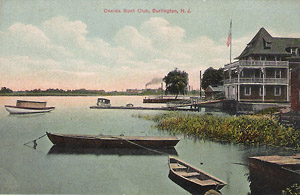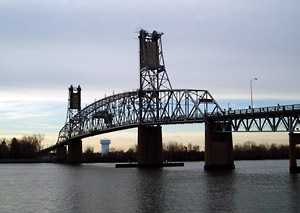Burlington, NJ

Boating was a popular leisure activity in the nineteenth century. The Oneida Boat Club, organized in 1873, is the oldest boating association in continuous operation on the Delaware River. Credit: Herman T. Costello Collection
The recreational boats and commercial barges moving up and down the Delaware River offer little hint of the important role that the river has played in the life of Burlington. Long before the first rudimentary roads or railroads were established, the Delaware River was the primary conduit for trade and settlement, and the city’s link with the outside world.
Burlington was a well-established river crossing before English Quakers landed here in 1677. Arent Schuyler, an early Dutch settler, operated a tavern and rope ferry to convey wagons and passengers between Burlington and Bristol, Pennsylvania. The English colonial government chartered an official ferry between the two towns in 1713.
Soon after its founding, Burlington became a major colonial port and maintained a brisk trade with Ireland, Great Britain, Europe, and the West Indies. A customs house operated at Burlington into the twentieth century. The city’s first shipyard was established in 1698 and shipbuilding was an important economic activity. Although its preeminence as a port declined with the growth of Philadelphia, Burlington’s boatyards continued to produce a variety of smaller sailing vessels. The racing yachts, skiffs, and sloops made by the Durrell and Fennimore firms were highly regarded for their speed and quality, and boating was a popular leisure activity for the city’s affluent in the nineteenth century.

Until 1931, Bristol was reached by ferry. The charter for this municipal ferry route was created in 1713. Credit: Herman T. Costello Collection
Although it was no longer a major port and center of government by the end of the eighteenth century, Burlington was at the hub of two revolutions in transportation that occurred within a fifty-year period. In 1788 the world’s first steam-powered boat began making regular trips between Philadelphia and Burlington. Inventor John Fitch (1743-1798) constructed the experimental craft. The Stevens family of Hoboken, N.J, who also developed the Camden and Amboy Railroad in the 1830s, pioneered the commercial use of steam-powered craft on the Delaware River. In 1809, their Phoenix was the first ocean-going passenger steamboat and the first to make regular trips between New York City and cities along the Delaware River.
Steamboats provided cheap, relatively fast, and convenient transportation; passenger service from Burlington continued into the early twentieth century. In 1834, another historic development in transport occurred when the Camden and Amboy Railroad, the third railroad built in the U.S., came to Burlington. Passenger service began in 1835. A railroad was built to link Burlington and Mt. Holly in 1849. In 1895 the Pennsylvania Railroad used this route to experiment with rail line electrification. In 1904 trolley car service opened in Burlington and continued into the 1930s.

The vertical lift Burlington-Bristol Bridge opened in 1931. The bridge deck and sidewalks were replaced in the 1990s. Credit: Burlington County Bridge Commission
During the Colonial era, Burlington was located along one of the few primitive roads between New York and Philadelphia. Burlington County’s first turnpike, which connected Burlington City and Bordentown, was chartered in 1808 but reliable roads and bridges were rare until the twentieth century. A ferry between Burlington and Bristol, Pennsylvania had operated since the seventeenth century. In 1931, the first bridge linking the two cities opened for traffic. Highways built in the twentieth century have had a great hand in changing the largely rural nature of the county. In 1951, the first 44-mile stretch of the New Jersey Turnpike reached the outskirts of Burlington. The NJ Turnpike was one of the most modern roads of its day and is a landmark in highway design. In 1956, a new bridge was built in Burlington to link the New Jersey and Pennsylvania Turnpikes. With the arrival of the light rail River Line linking Trenton and Camden in 2004, passenger rail service returned to Burlington.
For more information:
- https://en.wikipedia.org/wiki/John_Fitch_(inventor)
- inventors.about.com/library/inventors/bl_john_stephens.htm
- www.burlingtoncountyhistoricalsociety.org
- www.njtransit.com
Banner art: Steamboat Twilight leaving the docks at Burlington. Credit: Herman T. Costello Collection






